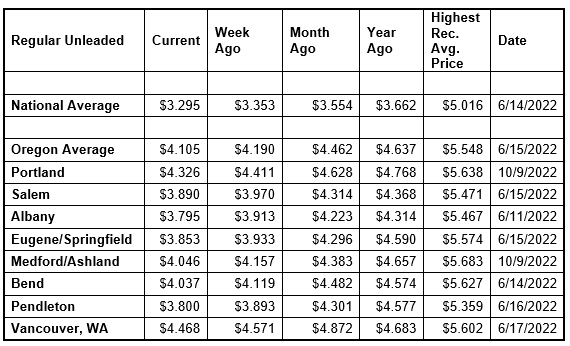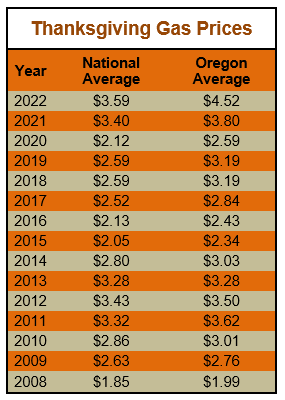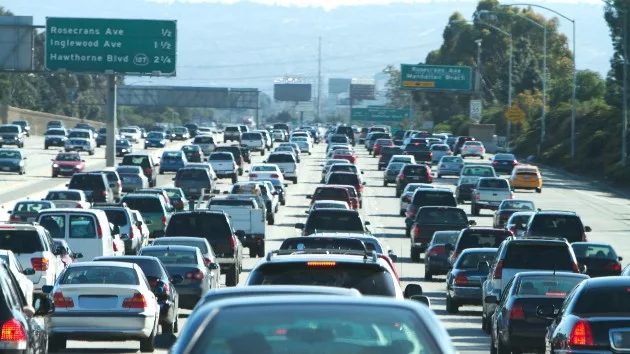Drivers are thankful for lower pump prices as Thanksgiving approaches. Gas prices continue to decline as millions of Americans hit the road for the long holiday weekend. Here in Oregon, drivers will pay about 40 cents a gallon less than last Thanksgiving. For the week, the national average for regular dips six cents to $3.30 a gallon. The Oregon average loses nine cents to $4.11.

“Pump prices should continue to decline in most markets through the Thanksgiving holiday weekend. Many gas stations in Oregon are already selling regular for less than $4 a gallon and more will join soon,” says Marie Dodds, public affairs director for AAA Oregon/Idaho.
AAA projects 55.4 million Americans including 785,000 Oregonians will travel for the holiday, up 2.3% from 2022. This year is expected to be the third-busiest for Thanksgiving travel since AAA started tracking in 2000, only behind 2005 and 2019. Most will drive to their Thanksgiving destinations. Find all the details in the AAA Thanksgiving travel news release.

The national average for regular has been steadily falling since reaching its year-to-date high of $3.88 on September 18. The Oregon average has been moving lower since reaching its year-to-date high of $4.77 on August 30.
Several Oregon markets now have averages below $4 a gallon including:
Albany $3.80
Corvallis $3.77
Eugene/Springfield $3.85
Florence $3.83
Hermiston $3.89
Hood River $3.97
Keizer $3.82
Lincoln City $3.68
Madras $3.70
McMinnville $3.88
Newport $3.47
Pendleton $3.80
Redmond $3.88
Roseburg $3.82
Salem $3.89
Thirteen Oregon counties have averages below $4 a gallon:
Benton $3.79
Douglas $3.97
Gilliam $3.90
Hood River $3.89
Jefferson $3.78
Lane $3.85
Lincoln $3.64
Linn $3.79
Marion $3.85
Morrow $3.87
Polk $3.90
Umatilla $3.82
Wasco $3.96
Crude oil prices have been volatile since the start of the conflict between Israel and Hamas last month. Fears that the conflict could escalate across the Middle East sent crude oil prices near $90 per barrel in October. Crude prices fell into the $70s on November 7 and have remained there since then. While Israel and the Palestinian territory are not oil producers, there’ve been concerns that the conflict could spread in the Middle East, which could impact crude production in other oil-producing nations in the region.
Crude oil prices tend to rise when there are geo-political events involving oil producers. Crude prices spiked after the invasion of Ukraine by Russia last year because Russia is one of the world’s top oil producers, behind the U.S. and Saudi Arabia. Crude prices also surge on news of production cuts by major oil producers. Crude oil prices spiked above $90 per barrel in mid-September, the highest price since last November, in response to the announcement from Saudi Arabia and Russia that they would keep their production cuts in place through 2023. The cuts are one million barrels a day by Saudi Arabia and 300,000 barrels a day by Russia.
Gas prices normally decline in the fall, in part due to a drop in demand for gasoline compared to the summer months and the switch from summer-blend gas to winter-blend gas. Winter-blend gas is cheaper to produce than summer-blend fuel as it contains ingredients such as butane, so gas prices normally fall when the switch occurs. Summer-blend gas helps reduce emissions from gasoline during the warm summer months. More info on summer- and winter-blend gasoline can be found at the EPA website. The switch occurs on September 15 except California, which normally keeps summer-blend gasoline until October 31. This year, California allowed the switch to occur earlier because of refinery issues in that state that sent pump prices soaring on the West Coast in late September.
Crude oil is trading around $77 today compared to $78 a week ago and $80 a year ago. So far this year, West Texas Intermediate has ranged between $63 and $94 per barrel. Crude reached recent highs of $123.70 on March 8, 2022, shortly after the Russian invasion of Ukraine, and $122.11 per barrel on June 8, 2022. The all-time high for WTI crude oil is $147.27 in July 2008.
Crude oil is the main ingredient in gasoline and diesel, so pump prices are impacted by crude prices on the global markets. On average, about 50% of what we pay for in a gallon of gasoline is for the price of crude oil, 25% is refining, 11% distribution and marketing, and 14% are taxes, according to the U.S. Energy Information Administration.
Demand for gas in the U.S. has decreased from 9.49 to 8.95 million b/d for the week ending November 10, according to the U.S. Energy Information Administration (EIA). The EIA’s estimate for demand is unusually high for early November, but when the EIA releases monthly demand data in a few weeks, it could revise it lower. Meanwhile, total domestic gasoline stocks decreased by 1.5 million bbl to 215.7 million bbl.
Lower gas demand, alongside declining oil prices, has contributed to pushing pump prices down. If gas demand and the cost of oil remain low, drivers can expect further pump price drops ahead of Thanksgiving.
Quick stats
Oregon is one of 46 states and the District of Columbia with lower prices now than a week ago. Utah (-17 cents has the biggest weekly drop. Hawaii (-1 cent) has the smallest weekly decline. Delaware (+20 cents) has the largest week-over-week increase.
California ($4.96) has the most expensive gas in the nation for the 17th week in a row but falls below $5 for the first time since July. Hawaii ($4.73) is second, Washington ($4.43) is third, Nevada ($4.25) is fourth, Oregon ($4.11) is fifth, and Alaska ($4.02) is sixth. These are the six states with averages at or above $4, same as last week. This week 32 states and the District of Columbia have averages in the $3-range. Twelve states have averages in the $2 range this week.
The cheapest gas in the nation is in Texas ($2.77) and Mississippi ($2.78). No state has had an average below $2 a gallon since January 7, 2021, when Mississippi and Texas were below that threshold.
The difference between the most expensive and least expensive states is $2.19 this week, compared to $2.27 a week ago.
All 50 states and the District of Columbia have lower prices now than a month ago. The national average is 26 cents less and the Oregon average is 36 cents less than a month ago. Arizona (-60 cents) has the largest monthly drop. Delaware (-2 cents) has the smallest.
All 50 states and the District of Columbia have lower prices now than a year ago. The national average is 37 cents less and the Oregon average is 53 cents less than a year ago. This is the eighth-largest yearly drop in the nation. Utah (-65 cents) has the largest yearly decrease. Texas (-23 cents has the smallest yearly decline.






